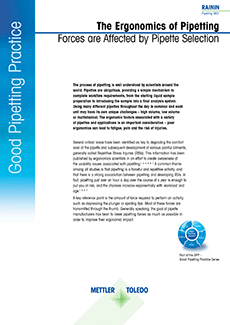 |
Positive displacement pipettes are important players in the laboratory liquid handling toolbox.
Volatile liquids vaporize, losing volume when in contact with air. Viscous liquids, due to their density, may expand or compress air when pressurized in a moving, closed chamber. For these reasons, these two classes of liquids cannot be handled using standard air displacement pipettes. Instead, liquid handling that involves volatile and/or viscous liquids requires a special tool for liquid transfer: the positive displacement pipette.
Pipette manufacturers offer both a single-aspiration/dispense version and a repeater version of the positive displacement pipette. This white paper focuses on the single-aspiration/dispense version. In addition to explaining the construction and mechanics of positive displacement pipettes, it offers summaries of three recently published papers where positive displacement pipettes played a critical role: a study comparing volatile flavor profiles in peas; a human heart protein interaction study requiring a highly viscous buffer; and a study of sperm production in roosters. Such investigations show how the unique attributes of positive displacement pipettes enable researchers to extend their field of inquiry.








